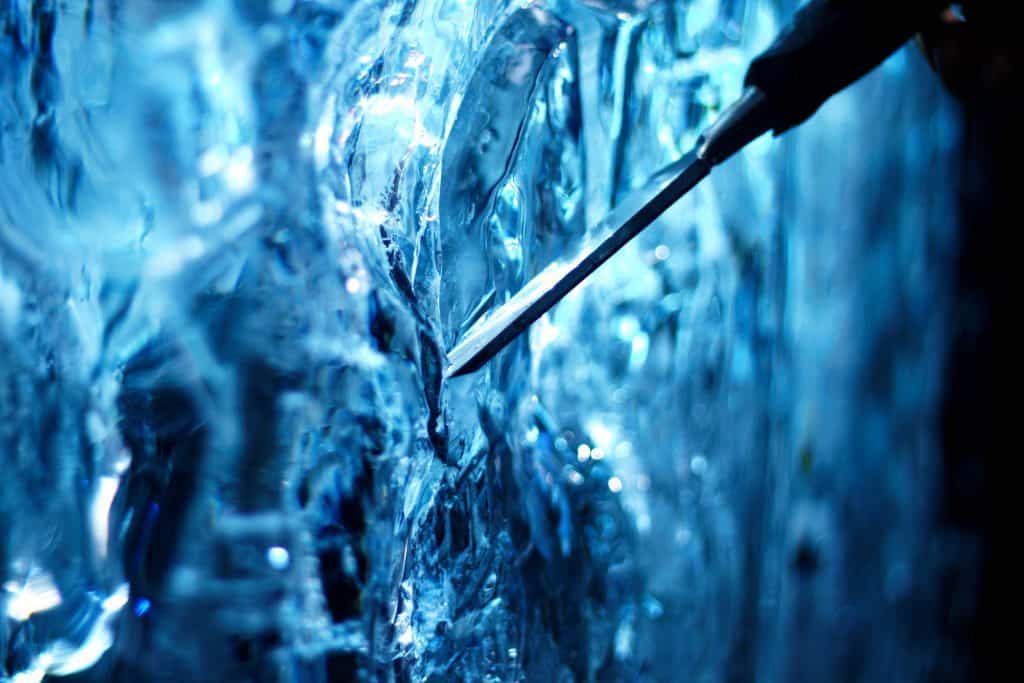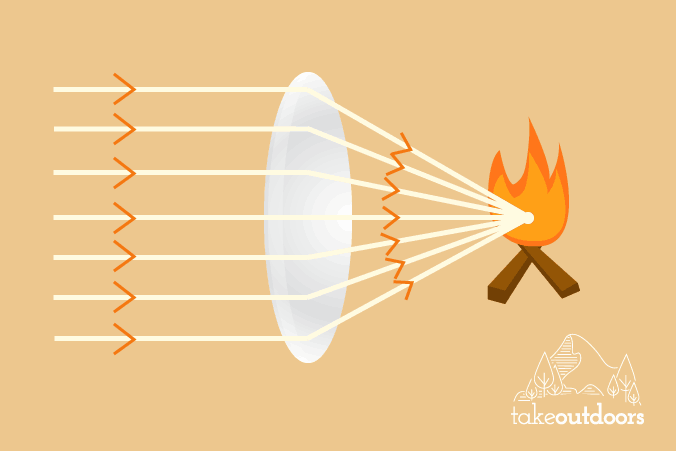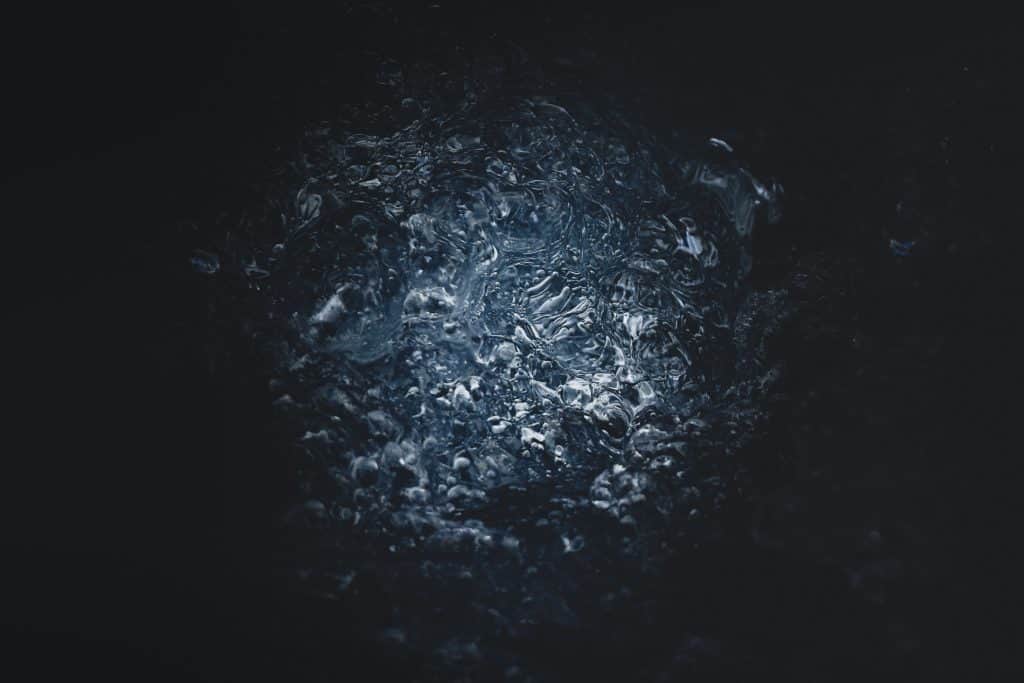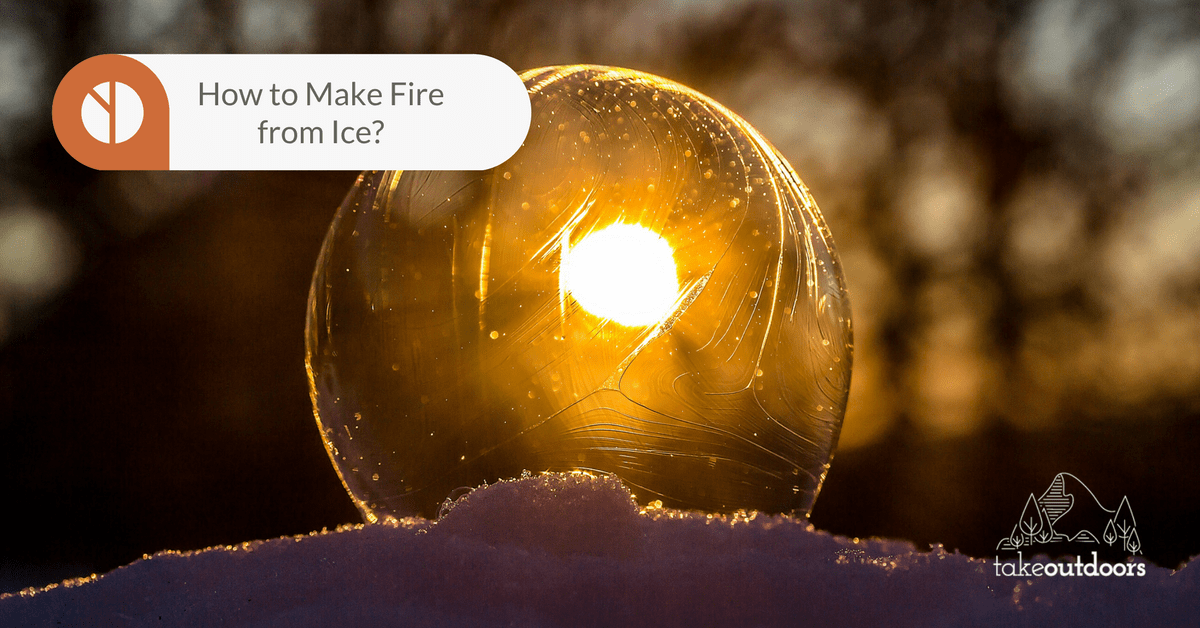We use affiliate links and may receive a small commission on purchases.
Read more about us.
Want to stop your sulky teen from texting in the middle of dinner? Ask him this probing question: Can you start a fire with ice? Tell him that you’re planning a family camping trip and that you’re going to be teaching him this new skill.
He’ll give you “that look” –perhaps accompanied by a major eye roll.
Show him that you’re not joking by taking possession of his smartphone and marching him over to the family computer. Inform him that until he watches the following video, he won’t get the device back and you’ll get his attention.
This move works every time in your effort to make fire from ice. It is still useful if you don’t think this will make your kid take notice of your intention to do something he likely believes impossible.
You’re going to learn a thing or two about him that will bring you closer together once you head off on that camping trip.
Besides…
…he’ll be all in if only to see you fail at making fire from ice—which you won’t, of course, thanks to our wisdom and your determination to show him a thing or two about your super powers.
Table of Contents
Start with the basics
You’ll build your confidence and show strength of purpose by assuming that you’ll make fire from ice by taking recommended steps from survivalists who know a thing or two about how to turn bits of pieces of nature into surprising results.
It helps to have a clear (excuse the pun) idea of your objective, and in fact, not just any block of ice is going to help you make that fire. You need a perfectly clear slab to do the job–which is why one of the most important jobs you’ll undertake is shaping your ice properly.
The fine art of ice shaping


It helps to think about your ultimate objective. You can emulate the process your science teacher revealed when she used a magnifying glass to show the class how a fire is made without matches.
Substitute ice for glass. Once you “get it,” you’ll have an easier time mastering the fire making-from-ice concept as depicted in these easy-to-follow directions.
You might even feel confident enough to share your newfound wisdom with others!
Once you’ve achieved a properly-shaped piece of clear ice, your next move is to turn it into the intermediary that literally collects light rays that originate from the sun and bends them like rainbows so they emerge from your ice lens capable of igniting organic material. The concentrated heat causes combustion when the organic matter reaches a certain temperature and the end result is fire.
Following this so far?
If not, we recommend a second viewing of that video and that Instructables tutorial with images, with or without your kid.
What is the refractive index of ice?
Did your eyes glaze over when you read this sub-head?
Relax.
We’re just introducing you to the scientific concept. This offers a more in-depth examination of the process of morphing ordinary ice into a cozy fire.
Besides, You can add this knowledge to your repertoire of interesting info when you sit around that campfire. You never have to admit that your science grades were less than perfect.
The bottom line is that those light rays speed their way to Earth from the sun. The bending action takes place at the speed of light. The jump-starting action literally changes as it passes through different substances—like the properly-shaped chunk of ice.
Scientists trying to make sense of this concept created a refractive index of ice so everyone from campers like you to physicists, mathematics and science experts have a formula with which they can work to explain this phenomena. The refractive index of ice is a number that lacks dimension. Yet it is always greater than or equal to the number one.
Why?
Because the speed at which light travels always slows down when it comes into contact with mediums other than those mysterious vacuums in space.
If you’re intrigued by this refractive index of water conundrum, you may wish to learn more about the dude who came up with this theory: Willebrord Snell (1591 to 1627).
His reward?
Having Snell’s Law named for him. His concept of a refractive index of water was also added to the larger body of scientific research.
The science of prisms and lenses
If you think we’re being a bit obsessive about the role the shape of your ice plays in the process of turning fire into ice, you can continue to be skeptical.
But, you’ll contradict legions of scientists who have descended from an ancient Greek inventor named Archimedes who supposedly used glass mirrors to set fire to Roman ships that attacked his Syracuse homeland in 212 B.C.
Some say this is a myth.
Others don’t question the possibility.
President Obama was so curious about the topic. He challenged the “Mythbusters” TV hosts to prove that Archimedes was literally full of hot air. Turns out there’s merit in this historical accounting so the story of this Roman fire remains viable. Maybe Obama is even mulling this historical happening now that he’s retired!
Glass or ice lenses?


Either one is the same if shaped properly. Both are the product of photons that direct light from sun to earth, stopping momentarily on properly-focused prisms and lenses positioned over vegetation.
This confrontation, as we’ve said (but like your mom, we like repeating so it sticks), bends those light rays. This starts refocusing them in the direction of organic matter until heat builds to around 450 degrees F.
At that point, kindling begins smoldering and it’s just a matter of time before you’ve got yourself a fire.
Collect some basic equipment
Sick of reading theory and impatient to actually build a fire from ice?
No worries.
We just wanted to make sure that this concept is firmly affixed to your brain before moving on to all the action. The bad news is that you’ll need rudimentary supplies to start your experiment.
The good news is that you won’t have to plunder your child’s college fund to acquire what you need to turn ice into fire. These supplies are likely already hanging around your house or garage.
But, onto your list:
You’ll need gloves, a sharp knife. Great if you can find scraps of concrete. These are capable of acting like a super-hard file for grinding and shaping that solid piece of ice.
And of course you’ll need a bundle of kindling where that fire will concentrate on. It will be heated up by hot sun rays filtering through your cool lens.
Thought we were going to pile on required supplies? Ye of little faith. This is a survivalist skill not a trip to Costco. Will you resemble Arctic explorers when you set off on your “primitive” camping trip after gathering your stuff? Not if you’ve got common sense.
Peruse this checklist to decide if you want to look like a Bedouin. This can help achieve your goal of learning “how to make a fire with ice.”
We see you nodding your head now.
Excellent. You’re beginning to prioritize simplicity as you morph from consumer to survivalist.
Ice is nice; clear ice is better


Think getting your gloved hands on a hunk-O-ice is no big deal? Don’t kid yourself.
You need clear ice and you may be able to achieve that by boiling, freezing or tapping your inner caveman and extricating a chunk from a pond or stream.
On the other hand, erstwhile city dweller, you can make in your freezer, but be prepared for disappointment. You know those cloudy sections of ice that appear from out of nowhere?
Sadly, they thwart the process of making a fire with an ice lens. The light still bends as it transits your precisely-shaped hunk of ice. But it will literally stop in its tracks when encountering cloudy material. This behooves you to take your ice-making task very seriously.
Some wilderness pros accomplish perfect ice by boiling water to de-gas it. They then pour the boiled water into a balloon so it assumes the spherical shape you seek.
This makes a good experiment if the idea chipping away at a block of ice to achieve that convex/concave ice lens shape sounds like too much work or you haven’t got many Band-Aids on hand.
On the other hand…
…if you’re seeking the full-on wilderness experience and a balloon doesn’t factor into that aim, get your hands on big block of ice. See how it feels to function as an ice sculptor. Separate clear from cloudy sections so you wind up with a chunk of transparent ice.
If your clear section of ice happens to sustain a crack or two, don’t be concerned. Only those cloudy elements must be vanquished to achieve your final goal, Sir IceAlot.
Here’s where your teen comes in handy.
Show him how to shape the clear ice using the tools you brought to saw, cut, “sand” and polish.
Or maybe you two can make this a shared effort that gives you time to talk to each other as you both learn how to make fire with ice.
It’s been known to happen. A conversation, that is.
Borrow tips from the cocktail set
We’ve no clue why it’s so important to fill a cocktail shaker or highball glass with perfectly clear cubes. If it helps you master ways to learn how to make fire from ice, no explanation is necessary. Just keep reading.
According to the website Epicurious, your search for ice Nirvana is as easy as pouring water into a cooler and sticking that cooler into a freezer. If you have access to a super-big freezer with room enough to house that cooler.
For reasons only the folks at “Bon Appétit” understand, this simple action sets in motion a process that freezes the water from the top down so displaced air bubbles sink like the Titanic.
Timing is everything: You’ve got to remove your icy creation before those bottom-feeding bubbles harden. You’ll need to monitor the progress of your freeze as often as you can spare the time. A deck of cards helps.
That’s not the end of the wisdom dispensed by Epicurious…
If you boil water before filling your freezing vessel, chances that your finished ice block(s) will be super clear are excellent. Multiple water boils may diminish the amount of cloudiness even further.
But, keep this in mind: you’re not seeking approval from the ice gods: you’re practicing survivalist skills.
Our mantra? Whatever works while on your mission to make fire from ice is worthy of your respect. So if your chances of coming up with ice that’s perfect is to boil distilled water twice, we won’t stop you from doing just that.
Three other adventurous methods to try
Wilderness expert David Grossman learned early on during his quest to identify and try primitive lifestyle tricks that there’s more than one way to start a fire without matches. Once he mastered the art of how to make fire from ice, he moved on to other creative methods that he refers to as his “burn, baby, burn” techniques.
They will be particularly useful if you live in Miami or Phoenix where the sun will work on your behalf but you’ll have to make and then carry your pristine ice to your campsite rather than hacking through a pond as you seek the answer to your burning question, can you start a fire with ice?
But, we digress. Time to turn your attention to three creative alternatives that are just as much fun.
Alternative #1
Will refractive index of water work for you in the real world? Of course. Here’s how…
You’re out with the family and you can’t get your hands on ice to start a fire with water, so do the next best thing and use the original source for ice: plain old water. You’ll need a plastic sandwich bag to do the job and you won’t have to worry about cloudy matter that develops during the freezing process.
Subject your baggie of water to the rays of the sun and let solar power do the job for you as you position this water pouch adjacent to your kindling. In a pinch, urine has been used to do the job. Just ask the Navy Seals.
Alternative #2
Sacrifice your chocolate. Go ahead and sulk if you must…
Resurrect an aluminum can from your bag of recyclables, briskly run the chocolate bar over the bottom of the can until it shines like a mirror courtesy of that crucial ingredient: butterfat.
Once you’ve got your shine on, angle the treated end of the can toward the direct sunlight and the can replaces that ice prism as an alternative conductor.
Pile up some kindling beside the can so it stays focused on its job of bending those light rays and you’ll trigger a flame once the chocolate-smeared can bottom heats to a proper temperature.


Watch this video on YouTube
Alternative #3
Make fire with citrus fruit! You did bring limes for the Corona, right?
Rub the a lemon or lime with your hands to distribute the juices under the skin. Sink a dozen nails into the fruit and then string a network of copper or another highly conductive wire between the nails to produce a tropical-smelling power conductor


Watch this video on YouTube
Place paper or kindling on the ground, use your fruit to generate that fire and voila! You’re the electric lemon genius. No citrus fruit packed for the camping trip? No worries. Build something similar with a potato.
https://youtu.be/updHpql1kEE
6 great reasons to learn how to make fire with ice
You have to admit that we live in an uncertain world—one that changes at meteoric speed as society careens from one advancement to another, and while technology has revolutionized the way we live our lives, it’s not just wise but prudent to think seriously about survival if for no other reason than you’ll find yourself sleeping better at night.
Possessing the knowledge and skill it takes to fashion fire from ice could come in handy down the road, and the following are just a few reasons to keep in mind the value of having this information at your fingertips.
- Being savvy about all manner of primitive tools and formulas for survival not only feeds your imagination but gives you the sort of insurance no policy can provide.
- Become a resource and role model by acquiring skills like finding food, staying warm, building shelter and starting fires using nothing more than what’s around you on a camping trip into Mother Nature’s kingdom.
- Set a terrific example for your children. Sure, they’re well-practiced in the arts of looking bored and nonplussed, but your talent and ingenuity for impromptu survival skills will impress them. Happens every day.
- Educators bemoan technology as not only robbing kids of time but ingenuity. Provide a wilderness experience and kids are forced to replace texting with thinking and brain-rotting video games with creative tasks.
- Nothing is more therapeutic than escaping traffic, city life, work worries, stress and tension than a camping trip that requires you to use your brain muscle to the max. A required act? Locking electronic devices in glove boxes for emergency use only.
- Don’t underestimate the pride you and your family will feel when you successfully build a fire from your crystal clear ice lens. It’s worth a selfie at the very least! Don’t be shocked if the image winds up on Facebook, Snapchat and Twitter courtesy of your offspring.
BTW: We won’t tell if you’re the person who distributes your masterful work on social media. Just sayin’.
A final word about survivalist techniques and their value
According to master tree huggers at the Alderleaf Wilderness College in Snohomish County, Washington: guys don’t have to grow long beards and women aren’t required to let the hair on their legs grow out to develop a certain appreciation for skills that allow one to stay alive, no matter what circumstances may befall you.
We mention this because the folks at Alderleaf don’t even mention how to make fire with ice or how start a fire with water until they first introduce the topic of “attitude” on their website.
Their point? If you believe you can survive–both because your instincts are honed and because you’ve had the presence of mind to learn to live off the grid (that includes reading this article and applying what you’ve learned), your chances of survival soar.
The Rule of Threes
Make turning ice into fire just the start of your education
Your preparation for all eventualities should never be casual. Do remember to be thorough so you don’t wind up freaking out should something dire happen.
Remember: if you freak out, so will everyone around you and that’s something you want to avoid at all cost.
So what’s your mantra?
“We’re going to be fine.” Say it like you mean it.
Plenty of people have gone to wilderness school to learn these methods and techniques. Others have been following the trend that recommends developing a survivalist state of mind by collecting and storing supplies (e.g., non-perishable foodstuffs and water) to meet unexpected circumstances of the most extreme kind.
You might actually have fun learning to build a shelter from nothing, getting the hang of installing solar panels. Maybe even figuring out how to locate and identify natural water resources and mastering purification techniques that make that water safe.
Further, learning to identify plants that are food sources is fun and could be a lifesaver, too. You and your family are going to wind up spiritually, physically and emotionally stronger. This is the result of exploring this world of natural solutions to basic needs.



Great article! It can be difficult to get the youth of the current generation to pay heed. Get them interested in seeing you fail is a great incentive. 😀